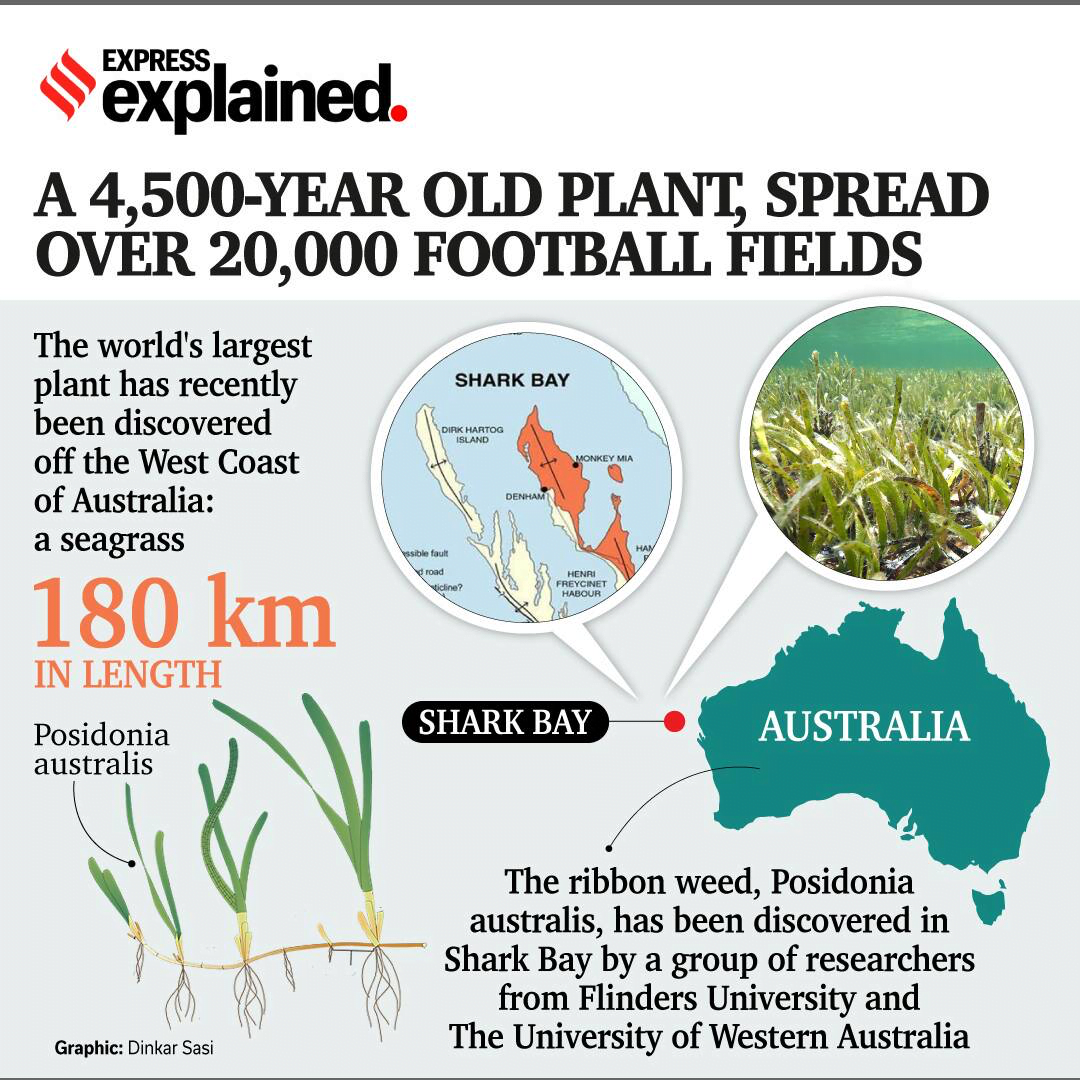Environment & Ecology
In News: The world’s largest plant has recently been discovered off the West Coast of Australia: a seagrass 180 km in length.
- The ribbon weed, or Posidonia australis, has been discovered in Shark Bay by a group of researchers
- These researchers have also found that the plant is 4,500 years old, is sterile, has double the number of chromosomes than other similar plants, and has managed to survive the volatile atmosphere of the shallow Shark Bay.
Plant’s Size
- The ribbon weed covers an area of 20,000 hectares. The next on the podium, the second largest plant, is the clonal colony of a quaking Aspen tree in Utah, which covers 43.6 hectares. The largest tree in India, the Great Banyan in Howrah’s Botanical Garden, covers 1.41 hectares.
- The existence of the seagrass was known, that it is one single plant was not.


- Researchers sampled seagrass shoots from across Shark Bay’s variable environments and generated a ‘fingerprint’ using 18,000 genetic markers – the result was sampled seagrass shoots from across Shark Bay’s variable environments and generated a ‘fingerprint’ using 18,000 genetic markers – just one plant has expanded over 180km in Shark Bay, making it the largest known plant on earth.
How did it grow, and survive for, so long?
- Sometime in the Harappan era, a plant took root in the Shark Bay. Then it kept spreading through its rhizomes
- Ribbon weed rhizomes can usually grow to around 35cm per year, which is how the scientists arrived at its lifespan of 4,5000 years.
- The researchers found that the ribbon weed cannot spread its seeds, something that helps plants overcome environmental threats.
- The ribbon weed has managed to survive environmental threats – a part of the reason may be that it is a polyploid – instead of taking half-half genome from both parents, it took 100 per cent
- This ribbon weed has twice the number of chromosomes other plants of the same variety have.
- Polyploid plants often reside in places with extreme environmental conditions, are often sterile, but can continue to grow if left undisturbed, and this giant seagrass has done just that
Seagrass
- These are flowering plants that grow submerged in shallow marine waters like bays and lagoons.
- These have tiny flowers and strap-like or oval leaves.
- Sea grasses evolved from terrestrial plants that colonised the ocean 70-100 million years ago
- Like terrestrial plants, seagrasses also require sunlight for photosynthesis from which these manufacture their own food and release oxygen
Reproduction:
- Sexual Reproduction Method: The pollen from the flower of the male plant is transferred to the ovary of the female flower through this method.
- Asexual Reproduction Method: Seagrasses can also reproduce asexually by branching off at their rhizomes
Significance:
- Seagrasses are considered ‘Ecosystem Engineers’ as they are known for providing many ecosystem services and are also called ‘the lungs of the sea’ as they release oxygen into the water through photosynthesis.
- Sequesters up to 11% of the organic carbon buried in the ocean even though they occupy only 0.1% of the ocean floor and absorb 83 million tonnes of carbon from the atmosphere annually.
- Seagrasses can capture carbon from the atmosphere up to 35 times faster than tropical rainforests.
- Help maintain water quality by trapping fine sediments and suspended particles in the water column and increase water clarity.
- Filter nutrients released from land-based industries before they reach sensitive habitats like coral reefs.
- Prevent soil erosion as the extensive vertical and horizontal root systems of seagrasses stabilise the sea bottom.
- Provide food as well as habitat for fishes, octopuses, shrimp, blue crabs, oysters, etc.
- Endangered marine organisms like dugong (Sea Cow), green turtle, etc, graze directly on seagrass leaves.
- Protect juvenile and small adult fish from large predators and also protect worms, crabs, starfishes, sea cucumbers, sea urchins, etc, from strong currents.
- Provide ideal nursery sites for important commercial marine life like squids and cuttlefish.
Previous Year Questions (PYQs)
Q.1) Consider the following pairs (2014)
Wetlands: Confluence of rivers
- Harike Wetlands: Confluence of Beas and Satluj/Sutlej
- Keoladeo Ghana National Park: Confluence of Banas and Chambal
- Kolleru Lake: Confluence of Musi and Krishna
Which of the above pairs is/are correctly matched?
- 1 only
- 2 and 3 only
- 1 and 3 only
- 1, 2 and 3
Source: Indian Express











